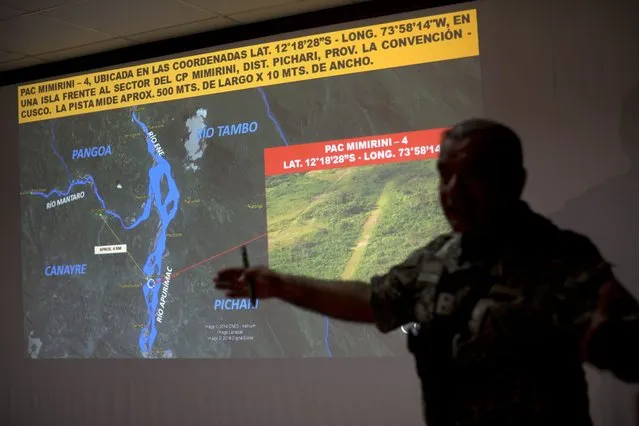
In this September 19, 2014 photo, a counternarcotics officer explains to the press the two weeks campaign to eradicate clandestine airstrips at the Mazamari counternarcotics military base in the Apurimac, Ene and Mantaro River Valleys, or VRAEM, the world's No. 1 coca-growing region, in Junin, Peru. The dynamiting of craters by Peruvian security forces into clandestine airstrips in the VRAEM cuts into profits but hardly discourages cocaine traffickers who net tens of thousands of dollars with each flight. (Photo by Rodrigo Abd/AP Photo)
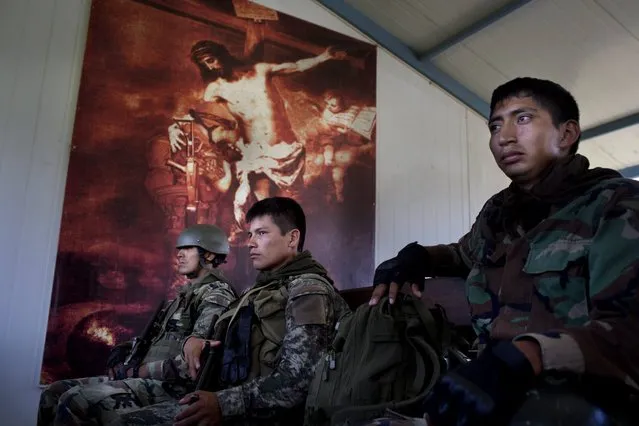
In this September 19, 2014 photo, soldiers sit, back dropped by an image of Jesus Christ embracing a praying soldier, inside a building at the Mazamari counternarcotics base in the Valley of the Ene and Apurimac and Mantaro River Valleys, or VRAEM, the world's No. 1 coca-growing region, in Junin, Peru. An average of about 4-5 small planes daily fly into Peru from Bolivia, picking up about 300 kilos each of coca paste worth about a third of a million dollars in Bolivia. (Photo by Rodrigo Abd/AP Photo)
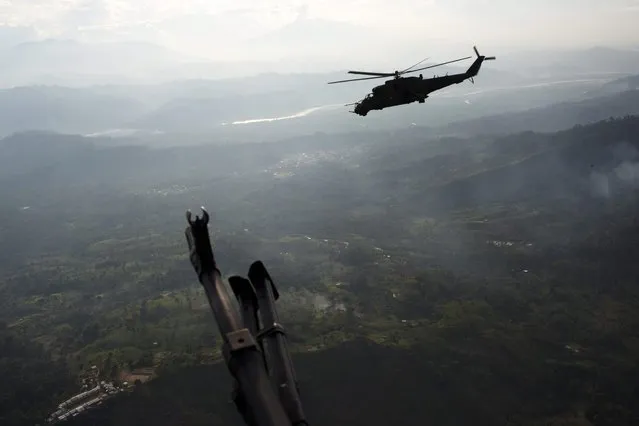
In this September 19, 2014 photo, a military helicopter flies over the VRAEM region, in Pichari, Peru. The region in the Apurimac, Ene and Mantaro River Valleys, or VRAEM, is the world's No. 1 coca-growing region. Security forces destroyed in the last two weeks more than 50 clandestine airstrips used by drug traffickers in the biggest offensive that seeks to combat the intense drug airlift to Bolivia. (Photo by Rodrigo Abd/AP Photo)
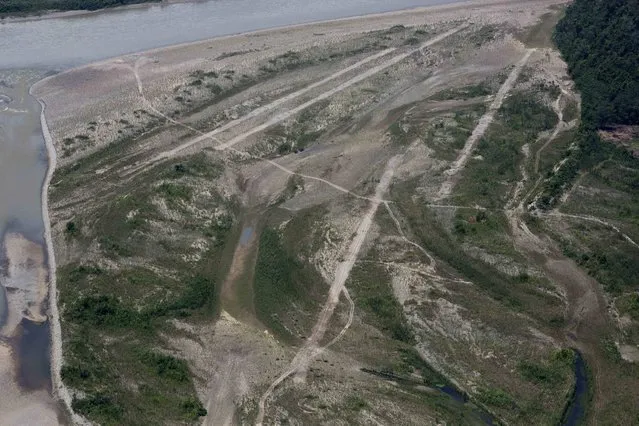
In this September 19, 2014 photo, clandestine airstrips are seen from a military helicopter in the Valley of the Apurimac, Ene and Mantaro River Valleys, or VRAEM, the world's No. 1 coca-growing region, in Pichari, Peru. The area has no radar coverage and the neighboring nations' air forces are limited so drug flights can only be intercepted on the ground. (Photo by Rodrigo Abd/AP Photo)
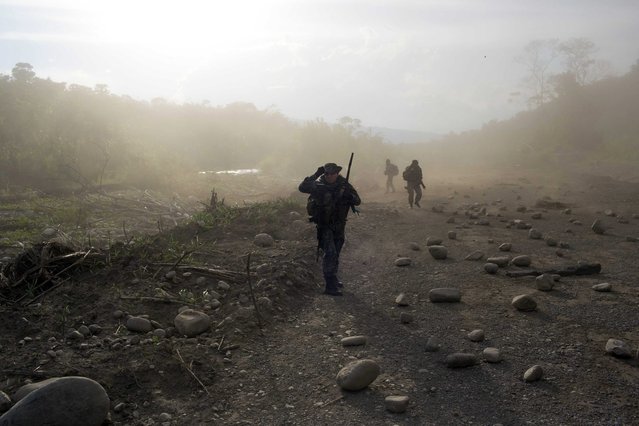
In this September 19, 2014 photo, counternarcotics officers walk in a clandestine airstrip strewn with boulders, in the Apurimac, Ene and Mantaro River Valleys, or VRAEM, the world's No. 1 coca-growing region, in Junin Peru. The boulders are used as a way to camouflage the airstrips from air observation. Security forces say that traffickers pay local villagers to keep the runways hidden and to repair them when they are cratered in counternarcotics operations. (Photo by Rodrigo Abd/AP Photo)
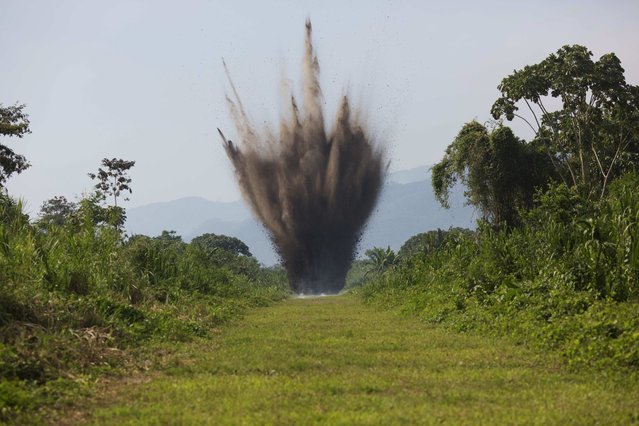
In this September 19, 2014 photo, explosives are detonate by Peruvian counternarcotics forces on a part of a clandestine grassy airstrip in the Apurimac, Ene and Mantaro River Valleys, or VRAEM, the world's No. 1 coca-growing region, in Ayacucho, Peru. The dynamiting of craters by Peruvian security forces into clandestine airstrips cuts into profits but hardly discourages cocaine traffickers who net tens of thousands of dollars with each flight flown from these airstrips. (Photo by Rodrigo Abd/AP Photo)
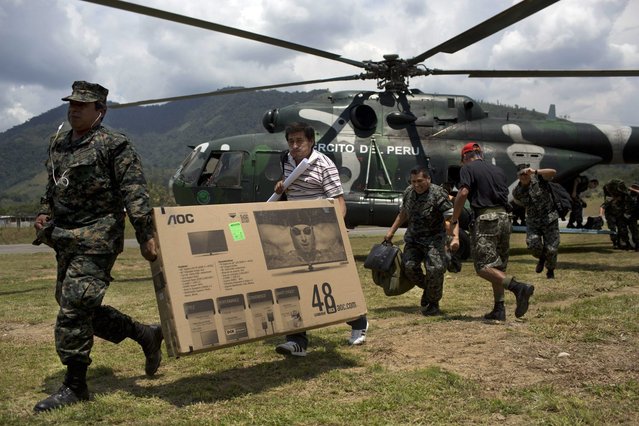
In this, September 19, 2014 photo, soldiers carry a TV after descending from a helicopter at Mazamari anti drugs military base in the Apurimac, Ene and Mantaro River Valleys, or VRAEM, the world's No. 1 coca-growing region, in Junin, Peru. According to authorities an average of about 4-5 small planes daily fly into Peru from Bolivia, picking up about 300 kilos each of coca paste worth about a third of a million dollars in Bolivia, where it is further refined. (Photo by Rodrigo Abd/AP Photo)

In this Friday, September 19, 2014 photo, a soldier signals to his commander while standing inside a crater created by explosives planted by Peruvian counternarcotics forces on part of a clandestine grassy airstrip, in the Valley of the Apurimac, Ene and Mantaro River Valleys, or VRAEM, the world's No. 1 coca-growing region in Ayacucho, Peru. According to official data, Peru has blown craters into 132 clandestine airfields this year, up from 110 last year. (Photo by Rodrigo Abd/AP Photo)
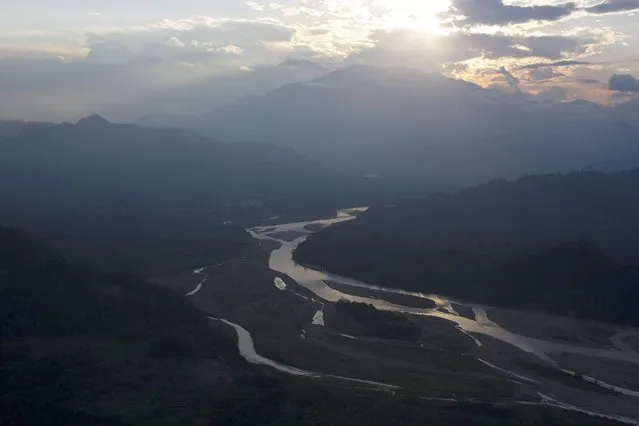
In this September 19, 2014 photo, the Ene river is seen from a military helicopter as it flies over the Apurimac, Ene and Mantaro River Valleys, or VRAEM, the world's No. 1 coca-growing region, in Pichari, Peru. (Photo by Rodrigo Abd/AP Photo)
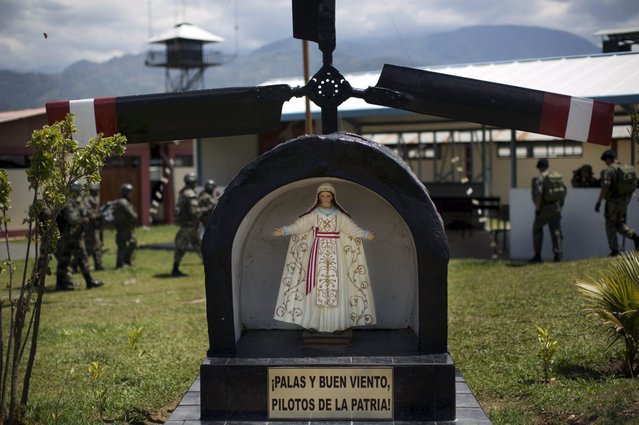
In this September 19, 2014 photo, The image of the Virgin of the military pilots is seen at the Mazamari counternarcotics military base in the Apurimac, Ene and Mantaro River Valleys, or VRAEM, the world's No. 1 coca-growing region, in Junin, Peru. The inscription below the image reads in Spanish “Blades and good wind, Pilots of the Fatherland”. (Photo by Rodrigo Abd/AP Photo)
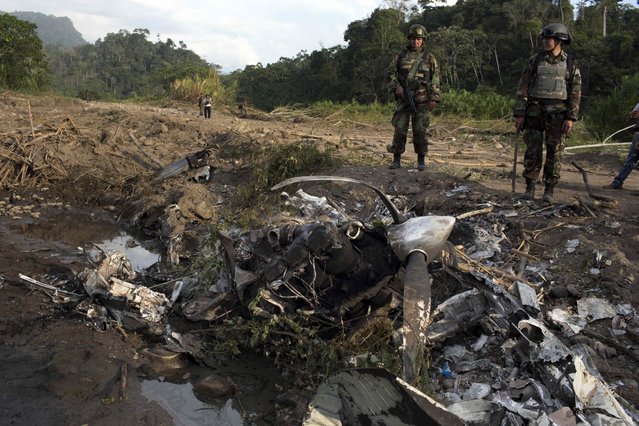
In this Friday, September 19, 2014 photo, Peruvian counternarcotics officers stand next to a plane destroyed allegedly by residents in an effort to hide evidence connected to clandestine airstrip, in the Valley of the Apurimac, Ene and Mantaro River Valleys, or VRAEM, the world's No. 1 coca-growing region in Junin, Peru. Authorities say an average of about 4-5 small planes daily fly into Peru from Bolivia, picking up about 300 kilos each of coca paste in Bolivia, where it is further refined. (Photo by Rodrigo Abd/AP Photo)
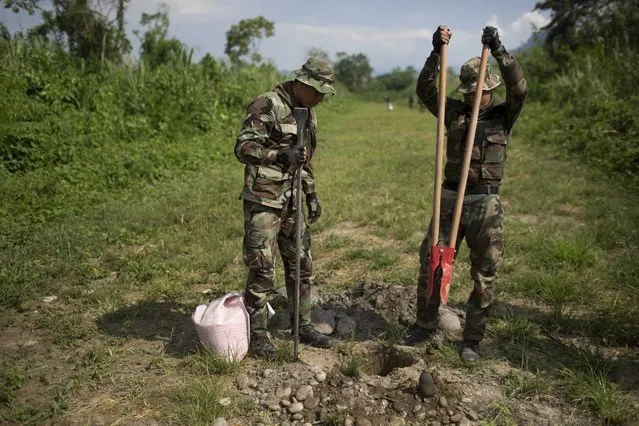
In this September 19, 2014 photo, counternarcotics officers make hole for placing explosives during the destruction of a clandestine airstrip in the Apurimac, Ene and Mantaro River Valleys, or VRAEM, the world's No. 1 coca-growing region, in Ayacucho, Peru. The dynamiting of craters by Peruvian security forces into clandestine airstrips in the VRAEM cuts into profits but hardly discourages cocaine traffickers who net tens of thousands of dollars with each flight. (Photo by Rodrigo Abd/AP Photo)
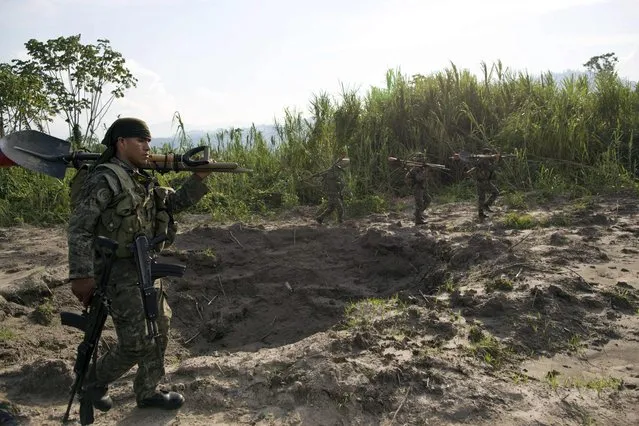
In this September 19, 2014 photo, soldiers walk around a crater created by explosives planted by Peruvian counternarcotics forces on part of a clandestine grassy airstrip, located in the Apurimac, Ene and Mantaro River Valleys, or VRAEM, the world's No. 1 coca-growing region, in Ayacucho, Peru. According to authorities traffickers pay local villagers up to $100 each to fill the holes blasted into the landing strips that dot the floodplain. (Photo by Rodrigo Abd/AP Photo)
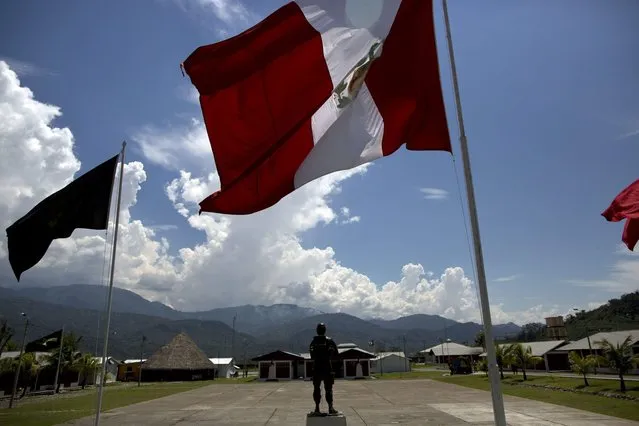
This September 19, 2014 photo, shows the Mazamari counternarcotics military base in the Apurimac, Ene and Mantaro River Valleys, or VRAEM, the world's No. 1 coca-growing region, in Junin, Peru. (Photo by Rodrigo Abd/AP Photo)
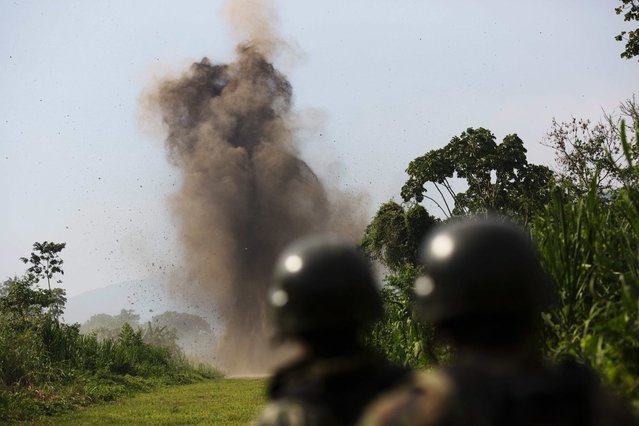
In this September 19 2014 photo, Peruvian counternarcotics forces watch the detonantion of explosives they planted on a part of a clandestine grassy airstrip in the Valley of the Apurimac, Ene and Mantaro River Valleys, or VRAEM, the world's No. 1 coca-growing region in Ayacucho, Peru. Peruvian authorities have launched an operation to destroy clandestine airstrips used by drug traffickers. (Photo by Rodrigo Abd/AP Photo)
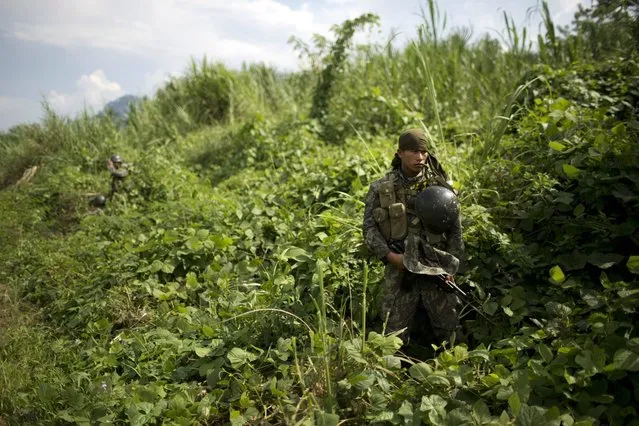
In this September 19, 2014 photo, a soldier stands guard during the destruction of a clandestine airstrip in the Valley of the Apurimac, Ene and Mantaro River Valleys, or VRAEM, the world's No. 1 coca-growing region in Ayacucho, Peru. Peruvian and Bolivian officials have agreed during a meeting in La Paz to share information in real time on cross-border drug flights. They did not, however, divulge details. (Photo by Rodrigo Abd/AP Photo)
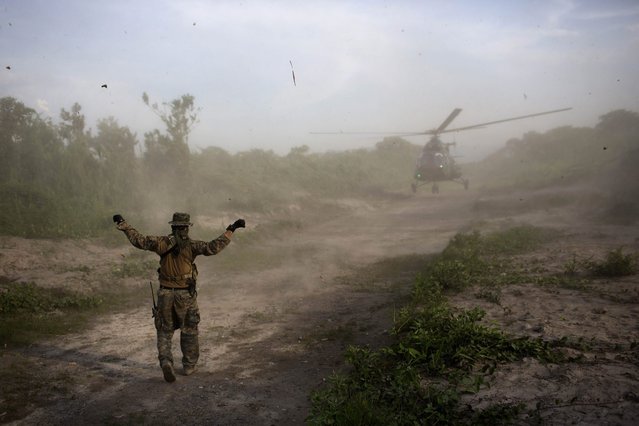
In this September 19, 2014 photo, a Peruvian counternarcotics agent signals to a military helicopter a landing area on a clandestine airstrip in the Valley of the Apurimac, Ene and Mantaro River Valleys, or VRAEM, the world's No. 1 coca-growing region in Junin, Peru. Security forces destroyed in the last two weeks more than 50 clandestine airstrips for drug planes in the biggest offensive that seeks to combat the intense drug airlift to Bolivia. According to authorities, two of the landing strips cratered in this latest operation have each been repaired four times this year, the 500-meter airstrips are fixed overnight. (Photo by Rodrigo Abd/AP Photo)
23 Sep 2014 12:56:00,
post received
0 comments
